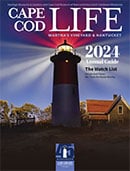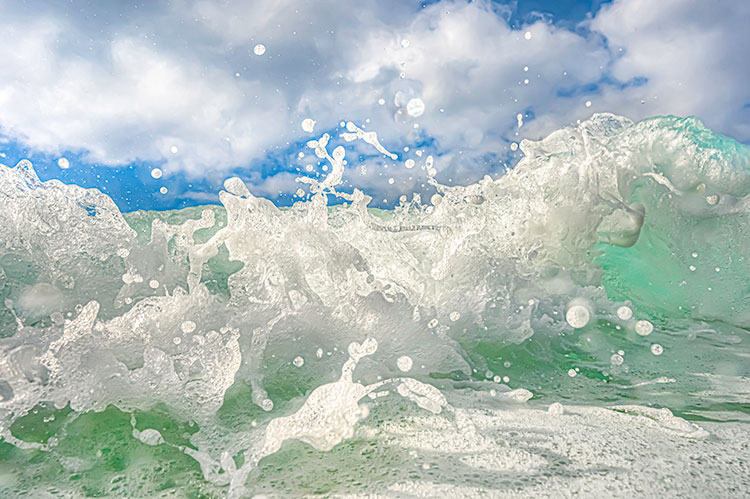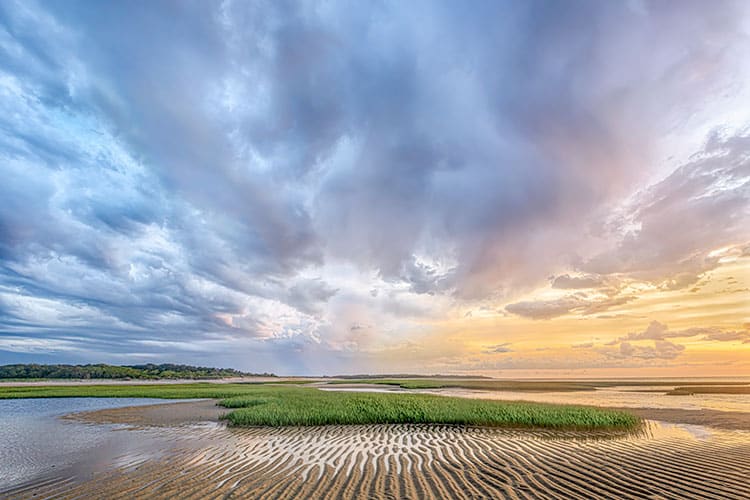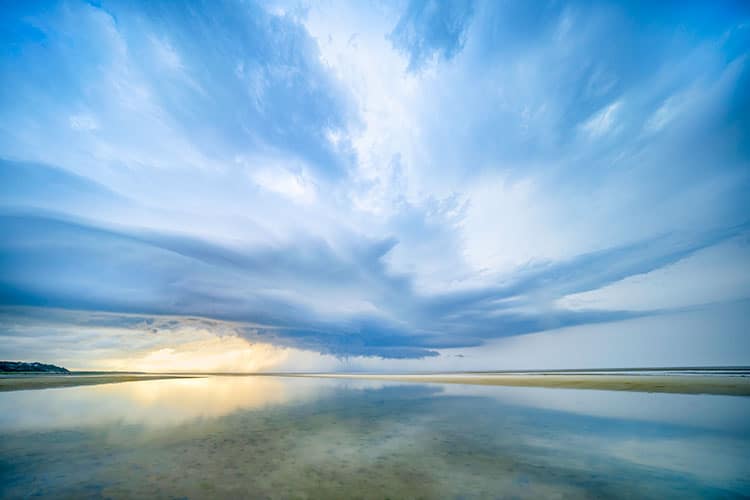
Cleansing Tides
Cape Cod Life / LIFE Annual 2024 / Nature
Writer: Chris White / Photographer: Steven Koppel
Cleansing Tides

Cape Cod Life / LIFE Annual 2024 / Nature
Writer: Chris White / Photographer: Steven Koppel
A new report of the quality of the waterways and ponds on the Cape reveals concerns as well as a path for hope.

The proverb “It’s an ill bird that fouls its own nest” first appeared in the written word sometime around 1250—in the Middle English poem, “The Owl and the Nightingale”—and yet, as humanity approaches the quarter turn of the 21st Century, the implications in that medieval wisdom still resonate. There’s no denying that much of our home environment suffers from the accumulation of “fouling.” Sometimes an area’s degradation is the result of outside interests, such as when mining company extracts ore. But in places deemed desirable to live, to vacation, or to retire, the human tendency to “improve” begins to destroy the very qualities that drew everyone in the first place. It’s only a matter of time before you start hearing the classic, “You should have been here twenty years ago….” Still, because something attractive remains, locals stick around and newcomers continue arriving. But growth begets that “ill bird” behavior, and suddenly the muck is so thick, it can be hard to see the original twigs and grasses of one’s proverbial nest.
Such has been the case on Cape Cod. Since the first European settlers began setting up shop here, the peninsula-turned-island has seen industries grow and collapse—fishing, whaling, wildfowl shooting, tourism, cranberry farming, and retirement, just to name a few—but some of today’s most dire environmental problems correspond most closely with the development boom of the 1970s and 80s and the population booms in towns from the Cape Cod Canal to Race Point. The equation is simple: more houses + more people = more waste. It should, therefore, come as no surprise to learn that the waters here—where the concept of “water” is so ingrained in the culture, lifestyle, and livelihoods of its inhabitants—have revealed their vulnerability in the shadow of growth.
For the second year in a row, 90% of the embayments on the Cape have tested as “unacceptable” in terms of water quality. More specifically, 43 of 48 of these failed in 2023, and while the 68% failure rate in 2018 was bad enough, the numbers can hardly get much worse. You may have noticed freshwater pond closures, as well—dog owners and friends certainly should have, since one bloom that sets off alarms is cyanobacteria, and this particular variety contains neurotoxins deadly to (wo)man’s best friend. Most of Cape Cod’s 890 ponds are at risk, but currently only 139 of them are being tested. Of these, 40% contained “unacceptable” water. There’s a simple explanation for this, and a fairly simple—if very expensive—solution. In contemporary vernacular, the idiomatic bird fouling its own nest has evolved into variations of “Don’t poop in your own backyard,” but unfortunately this is almost literally what has been happening on the Cape. Especially since the main culprit polluting our inland waters is sewage.

The watchdog of our local waters is the Dennis-based APCC, or the Association to Preserve Cape Cod, an organization that since 1968 has served as “Cape Cod’s advocate for the environment, working on behalf of the Cape’s residents and visitors to protect the natural resources that define our region.” This January, for the fifth year running, the APCC released its annual water health report: “The State of the Waters: Cape Cod 2023.” Executive Director Andrew Gottlieb explains that the organization evaluates and grades 48 embayments, 150 freshwater ponds, and the public drinking supplies. He says, “The State of the Waters” has three main functions: to provide the public an accessible, easily interpreted snapshot view of the situation; to create the basis for diagnosing region-wide factors that need to be addressed; and to inform our public policy recommendations. One of our goals is to educate; we believe that everyone on Cape Cod has some appreciation for water, and with a better-informed populace, a meaningful segment of people will take action.”
The APCC is not grading the open bodies of water such as the Atlantic, Cape Cod Bay, and Nantucket Sound; the term “embayment” refers to “nearshore outlets” that include estuaries, harbors, and bays. The “State of the Waters” includes an easy-to-read map that shows dots for each testing station: red for those testing at “Unacceptable; Immediate Restoration Required;” blue for “Acceptable; Ongoing Protection Required.” It looks almost like a connect-the-dots placemat in a local restaurant, only the dots that make up the coastlines of Buzzards Bay and Nantucket Sound are nearly all red. From Wareham’s Buttermilk Bay south to Woods Hole and around to Stage Harbor, in Chatham, only one blue dot appears: in Quisset Harbor. This stretch of the Cape’s west and south coastlines includes 41 of the 53 test sites. What does this mean, though, if an area fails? Andrew Gottlieb explains: “A finding of ‘unacceptable’ means that the embayment exhibits poor water quality at some points in year and reflects loading from septic systems. The tests reveal excess nutrients in the water due to nitrogen from poorly treated wastewater effluent that makes the bay inhospitable to marine life.” The increase in algae creates negative feedback loops, similar in some ways to greenhouse gasses in the atmosphere. Here, instead of CO2, nitrogen from sewage is the problem. “The nitrogen fertilizes the water, leading to algae growth. The water then becomes cloudy with lots of plant material, causing its temperature to increase, making the algae’s environment warmer,” says Gottlieb. It’s a perfect recipe for growing algae—or for killing an estuary or a bay.
This current water crisis isn’t the first to hit Cape Cod, but it would be nice if improvements in wastewater treatment, approaches to lawn care, and other changes at the individual, municipal, and state levels could restore the health of our waters once and for all. As recently as the 1960s—when former Woods Hole scientist Rachel Carson was writing and releasing Silent Spring, DDT was killing our ponds, embayments, and wide swaths of marine life (in addition to the ants and mosquitoes it was meant to target)—Harvard Professor Dr. Stanley Cobb published what became his most widely read essay: “Death of a Salt Pond.” His account of witnessing the devastating effects of DDT upon his favorite body of water appeared first in the Barnstable Patriot and later in the May 1963 issue of Audubon Magazine. He wrote this in a fury the day after an incident with the poison: “On Friday, August 3rd at 11:30 a.m. a helicopter flew along the northerly shores of the Cotuit narrows and emitted a cloud of DDT insecticide. The cloud of DDT contaminated me, my wife, my daughter and my grandchildren who were farther up the beach. This is about the final insult in a long, drawn-out tragedy that has been going on for a decade.” In his argument, Cobb then proceeds to note all the extinctions that he witnessed over that time span. He states: “Green herons were regularly present; ten years ago, two pairs were usual, three years ago, one pair; now, none…. One could go on ad nauseam reciting instances, but enough is enough. The pond is nearly dead.” The article would go on to help bring about the ban on the dangerous chemical, and some twenty years later (after his passing), wildlife such as the osprey began reappearing over his little pond.

Sadly, author David Churbuck’s 2012 account of changes in Cotuit Bay—a typical representation of an embayment on the coast of Nantucket Sound—echo the observations of Dr. Cobb. In his “Remembering Cotuit Bay the Way it Was and Why We Need to Clean it Up,” available on churbuck.com, he remembers catching his first fish in 1964, and notes that, “scallops would dart along, fast swimmers, with rows of neon blue pinpoint eyes, dozens of them, along their soft mantle.” His father and grandfather would take him fishing in the Seapuit River, where he recalls, “I’d look down through the water at waving fronds of eel grass and patches of yellow sand, waiting for something to bite the hook. Horseshoe crabs would cruise like tanks through the grass, along with hermit crabs, shoals of mummichog minnows and shiners, and sometimes even baby sand sharks. Once I caught a puffer fish (the only one I’ve ever seen on the Cape and which I doubt I’ll ever see again) which my grandfather tickled to puff up before unhooking and tossing it back overboard.” The embayment was an idyll, rich with marine life, but 48 years later, Churbuck’s own “State of the Waters” reaches the same conclusion as Cobb’s. He writes, “My grandparents knew a Cotuit with unpaved roads. I knew a Cotuit with eelgrass, pufferfish, and scup. The harbor is dead now. The eel grass is gone, the bottom is barren, lifeless, populated only by spider crabs and worms. Some fish still swim into the harbor from time to time—a few menhaden late in the summer, some striped bass and bluefish, and a few remaining herring on their way up to the ponds to spawn, but not much else.”
Given that Churbuck published his reminiscence in 2012, and that APCC’s testing has shown a significant decline in water quality since 2018, one might be forgiven for feelings of pessimism. Like, if 90% of the embayments have water quality that chokes the life out of all inhabitants besides algae, jellyfish, and spider crabs, then what’s the point. Hit the throttle on the old jet ski and head out into the Sound or the Bay, and don’t look back. But hope does remain, and the findings of APCC have helped not only to inform the public of the dire situation here on the Cape; they have helped shape policy. Scientists and a good many lay people have long known that excess nutrients are the cause of pond and embayment “deaths,” but up until recently, solutions appeared unrealistically expensive and/or like political suicide for local policymakers. Gottlieb says, “Ten years ago, selectmen were afraid to put initiatives on board, now the political price is being paid for not taking action. Back then, local governments argued about whether clean-up measures were even needed, then whether they were affordable. Now, both of these questions have been resolved.” At the state level, as well, the Cape has been recognized as a region in need of assistance. “A lot has been done by the legislature,” says Gottlieb. “They’ve put preferential tools in place, including low-or-no interest loans, that allow towns the ability to utilize funds from off Cape. And the public has recognized the need for providing clean water as essential to everything about the Cape.” In addition, despite the grim numbers from the testing sites, the uptick in recent project spending shows potential. “We’re seeing an explosive growth in the volume of money being put forward by communities,” says Gottlieb. “Five years ago, we were hoping for $65 million in project funds annually. Just three weeks into 2024, it’s $625 million. So, we’re seeing stuff that needs to happen, really beginning to happen.”

“The State of the Waters: Cape Cod 2023” did contain some other good news: our public water is doing well. Gottlieb reports, “Of the twenty-one entities that we test, nineteen had ‘excellent’ quality. Of the two not excellent, both were ‘good.’ No one ranked ‘poor,’ which is a positive variant from prior years.” Perhaps the issue of poor water quality is reaching its own high-water mark, just as DDT did back in the 1960s. And just as the movement of the tides helps to flush water systems, we may be seeing the beginning of a time of cleansing—for both the embayments and the freshwater ponds of the Cape. Gottlieb and the APCC are taking a realistic approach, but there’s some optimism, especially with the influx of project money and the progress that municipalities are showing around the issue. He says, “It took 50-100 years to screw this up, and it’s going to take 10-20 years to clean it. I think the changes will be incremental. We should begin to have better water clarity, less murkiness, and more oxygen in the water.” Perhaps then, the eel grasses will return, and new generations of kids will delight in seeing scallops winking up at them from below.
Chris White is a freelance writer for Cape Cod Life Publications.



